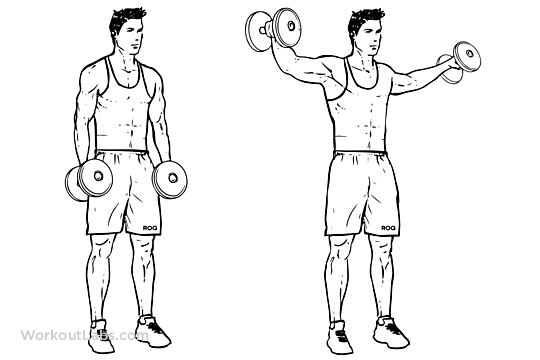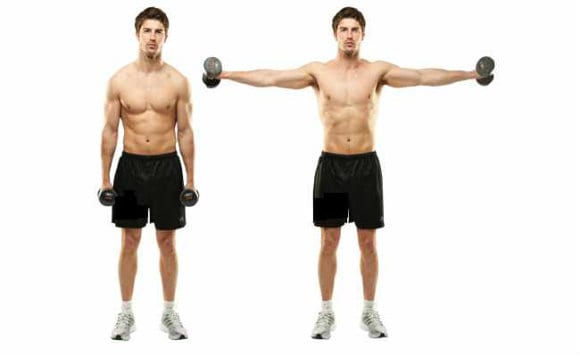Lateral Raises
Before talking about shoulder exercises, let's briefly state the anatomy of this muscle.
1. Muscles involved
The deltoid consists of three heads:
- frontal head
- side head
- rear head
The main purpose of this muscle is arm abduction, internal rotation, rotation external. During abduction work, the deltoid has the task of bringing the arm from 0 to 90 °; over 90 ° up to 150 ° the trapezium and the toothed also work in the work. Therefore, to work the deltoid and adjacent muscles, in the lateral lifts, it is sufficient to go up to 90 °.
2. How are they performed?
Let's now go on to explain the exercise related to the Lateral Raises.
In the lateral lifts the main muscles involved are the lateral head of the deltoid and the supraspinatus (if 90 ° is exceeded during abduction, the trapezius is also activated, descending bundles); in a secondary way they are the anterior and lateral heads of the deltoid (however, we must not forget that the deltoid is a single muscle and for this reason the other heads that compose it are also involved in the work) and trapezius (as already mentioned above); part of the work also passes to the biceps.
For a correct execution of the exercise, stand up, legs slightly bent and separated from each other with width equal to that of the shoulders; keep the elbows slightly flexed and the dumbbells on the sides of the body, with the hands facing the ground; avoid carrying the shoulders in an asthenic posture and arching the upper back to form a hump.
Having assumed the correct position, raise the arms in abduction until reaching 90 ° degreesi, aligning hands, elbows and shoulders. Once you have reached the point of maximum contraction, slowly return to the starting position, controlling the movement as much as possible.
This is an excellent exercise that allows a complete work of the deltoid, especially its lateral head, which allows you to gain width at the shoulders ... it is important not to forget that the bicep, especially the long head of the bicep, helps significantly in the performing this exercise, so it is important to take this into account when planning your workouts.

3. Common mistakes
The most common mistakes that are made during this workout are:
- sway with the body to aid execution;
- raise your hands but leave your elbows down;
- rotate the forearms;
- make a path that is too short;
- achieve an excessively long path, excessively loading the joints;
- use excessive load;
- do not control the lowering movement, let the weight drop;
- bending the elbows excessively, also caused by excessive weight;
- extending the elbows excessively;
- rise asymmetrically with the arms;
- speed up too much during the execution of the exercise.
Lateral raises are one of the many exercises that are, for the most part, bad executed and the most common mistake made is to flex the elbows too much and bring the arms forward to be able to lift more weight (this is because the point of application of the load is reduced and consequently it helps the execution with other muscles).

4. Variants
The possible variants are:
- Side raises with thumbs up: the muscles involved in this variant are the same as in the basic exercise with a greater emphasis on the frontal head of the deltoid. The execution of the movement is the same as the basic exercise but in this case the thumb is pointing upwards and the elbow moves downwards.
- Side raises with thumbs down: the muscles involved in this variant are the same as in the basic exercise, with a greater emphasis on the posterior and lateral head of the deltoid. In this variant there is no participation of the biceps and this increases the risk of shoulder dislocation. For this reason it is recommended to use little weight.
- Full side raises: in this variant the movement is continued until the arms are completely raised; in this case we also have a complete activation of the trapezius (remember what was said previously).
- Side raises on bench: with this variant, while sitting on a bench, it is possible to eliminate the thrust of the legs and trunk.
- Lateral raises to the low cable: using the cable it is possible to exploit the continuous tension generated by the cable pulling, therefore it is possible to partially eliminate the dead points, that is the points where the tension generated by the handlebars is lost.
- Lateral raises with one hand: the muscles involved are the same as in the basic exercise with greater muscle emphasis; in this case the hand that does not work is positioned either on the side or clinging to some external support.
- Lateral raises with one hand inclined body: the advantage of this variable is that a continuous tension is obtained throughout the movement, eliminating the dead points that are present in the basic exercise; in this way there is a much more effective work of the lateral head of the deltoid and also there is less tension in the back and lumbar area.
- Lateral raises with one hand extended: similar to the exercise described above but in this case the body is lying on the ground or on the bench, parallel to the ground.
- Lateral raises with bar: the advantage of this variable is that by using the bar it is possible to correct the errors in the positioning of the arm. Muscle stress is the same as that previously described; more advanced athletes can add discs to increase the difficulty.


























